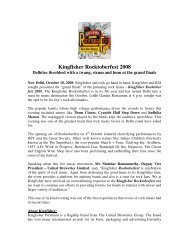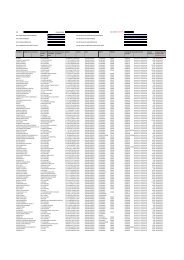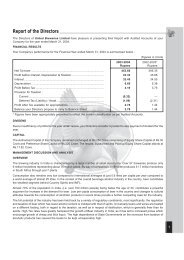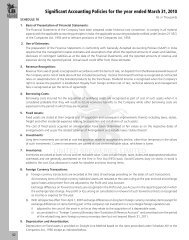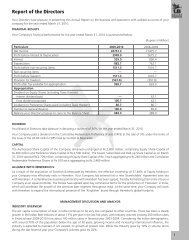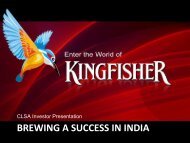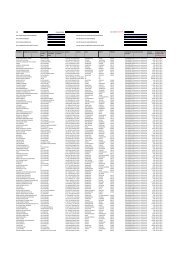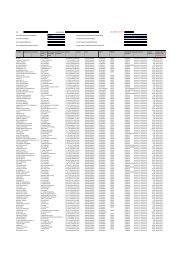Investor Presentation December 2011 - United Breweries Limited
Investor Presentation December 2011 - United Breweries Limited
Investor Presentation December 2011 - United Breweries Limited
You also want an ePaper? Increase the reach of your titles
YUMPU automatically turns print PDFs into web optimized ePapers that Google loves.
IR presentation <strong>2011</strong><br />
Brewing a success in India<br />
Guido de Boer<br />
CFO <strong>United</strong> <strong>Breweries</strong>
UBL: Key facts and figures<br />
10<br />
54%<br />
1.5<br />
18<br />
39%<br />
75%<br />
million hectoliters<br />
market share, the largest brewer in India<br />
litre per capita consumption<br />
owned breweries, and 10 contract<br />
breweries<br />
share for the Kingfisher brand - it is<br />
synonymous with Indian beer<br />
owned by Dr Vijay Mallya and Heineken<br />
Source: FY<strong>2011</strong> company Information, Industry Reports
India and the Beer opportunity
Source: <strong>United</strong> Nations (<strong>2011</strong>), McKinsey Global Institute (2007)<br />
Demographic dividend to be reaped<br />
Population increase fuels potential for rapid beer market growth<br />
India<br />
China<br />
Brazil<br />
Russia<br />
Population in 2030<br />
India<br />
China<br />
Brazil<br />
Russia<br />
Below 25 year olds as % of total<br />
population in 2030<br />
20%<br />
11%<br />
2%<br />
1%<br />
0 500 1,000 1,500<br />
mln<br />
India will have the world’s largest<br />
population by 2025<br />
In 2030, India will have over 1.5bn<br />
inhabitants<br />
Net increase in working population<br />
of 270 million by 2030<br />
0% 10% 20% 30%<br />
In 2030:<br />
20% of the world’s below 25 year<br />
olds will be Indian…<br />
…compared with 11% from China<br />
Significant growth in the legal<br />
drinking age population in India
Consumption is set for strong growth<br />
A significant middle class will emerge supporting increased spending power<br />
Household income<br />
brackets<br />
thousand, Indian rupees, 2000<br />
Globals (>1,000)<br />
Strivers (500-1,000)<br />
Seekers (200-500)<br />
Aspirers (90-200)<br />
Deprived (1,000)<br />
Strivers (500-1,000)<br />
Seekers (200-500)<br />
Aspirers (90-200)<br />
Deprived (
PCC in litres<br />
Beer consumption in India is well below<br />
other ‘BRIC’ countries<br />
The Indian beer market has grown strongly over the past 5 years from a low base<br />
Per Capita Beer Consumption<br />
80<br />
76.1<br />
64.5<br />
60<br />
40<br />
34.5<br />
20<br />
0<br />
CAGR 14%<br />
0.8 0.9 1.1 1.2 1.3 1.5<br />
2005 2006 2007 2008 2009 2010 China Brazil Russia<br />
India<br />
Source: Canadean (<strong>2011</strong>)
Today’s beer consumption is very low<br />
India is far below other emerging markets of similar income levels<br />
India<br />
Comparable Markets<br />
Per Capita Beer<br />
Consumption at<br />
comparable GDP<br />
1.5 liter 20 liter<br />
Share of alcohol<br />
consumption<br />
Two key reasons<br />
High prices & low availability<br />
AFFORDABILITY<br />
• Highest duty in the world<br />
• Duty not set according to<br />
alcohol content<br />
• Expensive alcoholic<br />
beverage<br />
AVAILABILITY<br />
• 65,000 licensed outlets<br />
across the country<br />
• 1 per 18,000 people<br />
• In China: 1 per 300 people<br />
Beer is not the alcoholic beverage<br />
of the common man
Affordability<br />
Beer prices in India are very high<br />
An Indian has to work up to 7x as<br />
long to afford a beer<br />
Minutes work for a beer<br />
India is the only BRIC where a beer<br />
is more expensive than a Big Mac<br />
Beer relative to Big Mac<br />
India<br />
51<br />
India<br />
1.1x<br />
Brazil<br />
18<br />
Brazil<br />
0.5x<br />
Russia<br />
8<br />
Russia<br />
0.5x<br />
China<br />
7<br />
China<br />
0.2x<br />
0 20 40 60<br />
0.0x 0.5x 1.0x 1.5x
Affordability<br />
Excise is highest among BRICs and drives preference for hard liquor<br />
Taxation is significantly higher<br />
than other countries<br />
Taxation of Beer<br />
Beer is taxed significantly higher<br />
than hard liquor<br />
Relative pricing vs<br />
spirits per unit of pure<br />
alcohol<br />
India<br />
Brazil<br />
Russia<br />
Kingfisher<br />
Premium<br />
75<br />
2.6x<br />
China<br />
Bagpiper<br />
29<br />
0% 20% 40% 60%<br />
Excise Duty VAT and other tax<br />
- 50 100<br />
Indicative rates as % of consumer price. VAT is only<br />
levied on value added, so effective rate is lower.<br />
Based on consumer prices in Tamil Nadu
Source: Company estimates. Percentages depict volume growth rates for FY11<br />
Availability<br />
Case Study: Mumbai Beer shops<br />
New Policy established<br />
Since the 1970’s no new licenses<br />
have been issued for liquor shops<br />
In 2006, the Maharashtra<br />
government started to issue ‘beer<br />
shop’ licenses for outlets that can<br />
only sell beer and wine, but not<br />
spirits<br />
…driving high growth in beer shop<br />
volumes<br />
31%<br />
Number of beer shops has increased<br />
sharply…<br />
300<br />
190<br />
215<br />
Mar10 Mar11 Nov 11<br />
…accelerating growth of the overall<br />
market<br />
4% 15%<br />
3%<br />
12%<br />
14%<br />
8%<br />
Liquor shops Permit rooms<br />
Beer shops<br />
Liquor shops Permit rooms Beer shops<br />
Industry
A highly regulated market<br />
Leveraging the existing framework<br />
Excessive State regulation and intervention<br />
• Route to market<br />
• Economics, need to have a brewery in each state<br />
• Pricing<br />
India is not homogeneous country<br />
• 27 uniquely different states<br />
Ban on advertising alcohol<br />
• Difficult to build new brands<br />
Requires ability to operating in very different<br />
structures
Per Capita Beer consumption<br />
Source: Canadean (<strong>2011</strong>), World Bank (<strong>2011</strong>), Company forecasts<br />
India is at the start of the growth curve<br />
Income growth will drive per capita beer consumption<br />
80<br />
60<br />
40<br />
Beer consumption versus income level<br />
Brazil<br />
Russia<br />
Mexico<br />
Vietnam<br />
Colombia<br />
China<br />
Demographics will fuel further market<br />
growth<br />
UBL expects to grow volume at an<br />
average annual rate of 15% over the<br />
next five years<br />
By the end of 2015, India is<br />
expected to reach 3 liter per capita<br />
20<br />
Philippines<br />
Kenya<br />
Nigeria<br />
India<br />
0<br />
$0 $5,000 $10,000 $15,000 $20,000<br />
GDP per Capita (in USD, PPP)
Capitalising on UBL’s strengths<br />
for growth
UBL’s leadership is undisputed<br />
Market leading position in India<br />
Strong market position will continue to drive economies of scale and superior<br />
returns<br />
All time high market share of over 54%<br />
UBL is more than two times its<br />
nearest competitor<br />
Carlsberg<br />
4%<br />
Mt Shivalik<br />
4%<br />
M Meakins<br />
4%<br />
AB-Inbev<br />
1%<br />
SAB<br />
23%<br />
Others<br />
10%<br />
UBL<br />
54%<br />
On a brand basis the leadership is even more apparent<br />
50%<br />
40%<br />
30%<br />
20%<br />
10%<br />
0%<br />
All-India market share FY11
What is this leading position resulting from?<br />
UBL’s Competitive Advantages<br />
UBL has been able to achieve its market leadership by<br />
leveraging four competitive advantages:<br />
Brands<br />
People<br />
Manufacturing<br />
footprint<br />
Route-to-<br />
Market
The strength of the Kingfisher Brand is<br />
unparalleled<br />
Iconic brand – KINGFISHER is<br />
synonymous with beer for Indian<br />
consumers<br />
No other beer brand comes<br />
close:<br />
All-India market share Mild Beer FY11<br />
Kingfisher<br />
Royal Challenge<br />
Fosters<br />
UB Export<br />
London Pilsner<br />
Budweiser<br />
Kalyani<br />
Sandpiper<br />
Tuborg<br />
Golden Eagle<br />
>6x<br />
0% 20% 40% 60%<br />
Brand Equity among young<br />
consumers:<br />
Kingfisher is India’s most liked<br />
beer brand by far. No.2 has only<br />
172k fans<br />
On a global basis, Kingfisher is<br />
the most liked alcohol brand<br />
after Heineken<br />
Leaving all global beers such as<br />
Budweiser and Corona, and<br />
renowned spirits as Smirnoff<br />
and Bacardi well behind it<br />
Brands in green are part of UBL portfolio
PRICE INDEX<br />
But it is not only Kingfisher…<br />
…UBL leads across all segments<br />
Mumbai mild beer portfolio Q2FY12<br />
Key brand<br />
Segment<br />
share<br />
No.2<br />
Relative<br />
share<br />
170+<br />
Super<br />
Premium<br />
65%<br />
Corona<br />
0.25x<br />
135<br />
Premium<br />
49%<br />
Carlsberg<br />
0.96x<br />
100<br />
Mainstream<br />
70%<br />
Fosters<br />
0.23x<br />
80<br />
Economy<br />
81%<br />
Golden Eagle 0.19x
Investing behind the brand<br />
Leveraging aspirational properties in fashion and sports<br />
Cricket: Indian Premier League<br />
Football: Kingfisher East Bengal<br />
Formula One: Force India<br />
Fashion: Kingfisher swimsuit calendar
Heineken<br />
Building brand equity for the future<br />
Selective launch in key metros: Mumbai, Delhi,<br />
Bangalore, Kolkata and Goa<br />
Gradual roll-out based on:<br />
1. Perfect execution<br />
Targeted Distribution<br />
Premium Visibility<br />
Cold & Fresh Stock management<br />
2. Driving awareness & be part of the conversation.<br />
Strong focus on digital media<br />
3. Set benchmarks at every touch-point - Quality over quantity<br />
K2 bottles<br />
World class PoS materials<br />
4. Leveraging UBL strengths in market<br />
IPS segment is still a very small part of the<br />
overall market
Manufacturing network across all major<br />
states<br />
UBL brewery footprint<br />
Unique brewery footprint<br />
• In line with the requirements of<br />
a complex regulatory<br />
framework<br />
• 18 owned breweries and 10<br />
contract breweries<br />
Closeness to market a critical<br />
success factor<br />
• Freight costs<br />
• Import and export duties<br />
• Freshness<br />
Owned breweries<br />
Contract breweries<br />
Ability to manage contract<br />
brewers in key states
Best Route to Market<br />
In distribution…<br />
India has 27 states that have distinctly different routes<br />
to market<br />
Ability to manage this complexity is one of UBL’s<br />
core strengths<br />
Established distributor relationships<br />
Group scale - with 60% share in spirits and 54% in<br />
beer - provides significant benefits<br />
Most distributors have been UB Group partners for<br />
multiple decades<br />
The best distributors and trade partners aligned<br />
with UB Group
Best Route to Market<br />
…as well as in retail<br />
freshness<br />
Cold<br />
stock<br />
Fastest selling<br />
brands<br />
Leadership in cold chain management<br />
Point of sale visibility<br />
Must stock brands provides portfolio<br />
benefits<br />
Economies of scale
People<br />
Most experienced management in the industry<br />
Customer facing management has been with the group for 20+ years<br />
Very low churn rate<br />
Strong background in dealing with regulatory environment and<br />
market complexities<br />
Very difficult for foreign entrants to replicate<br />
Chairman’s added value<br />
Dr Vijay Mallya provides significant added value as ambassador for<br />
the industry’s interests and is a member of parliament
UBL has a proven track record
Exceptional volume growth<br />
UBL volumes increased five fold in less than a decade<br />
UBL Sales volumes<br />
In Million Hectoliters<br />
12<br />
10<br />
8<br />
6<br />
5x<br />
4<br />
2<br />
0<br />
FY02 FY03 FY04 FY05 FY06 FY07 FY08 FY09 FY10 FY11
All amount are in Rs bln, for year ending 31 March<br />
Continued outstanding performance<br />
Performance highlights FY2006-<strong>2011</strong><br />
Sales up with an average 32% y-o-y<br />
40<br />
30<br />
20<br />
10<br />
0<br />
2006 2007 2008 2009 2010 <strong>2011</strong><br />
EBIT has quadrupled since FY2006<br />
4.0<br />
3.0<br />
2.0<br />
1.0<br />
0.0<br />
2006 2007 2008 2009 2010 <strong>2011</strong><br />
EBITDA exceeds Rs 4 billion<br />
5.0<br />
4.0<br />
3.0<br />
2.0<br />
1.0<br />
-<br />
Net Profit has grown with 54% CAGR<br />
2.0<br />
1.5<br />
1.0<br />
0.5<br />
0.0<br />
2006 2007 2008 2009 2010 <strong>2011</strong><br />
2006 2007 2008 2009 2010 <strong>2011</strong>
Closing remarks
In Summary…<br />
Indian beer market growth opportunity unparalleled in<br />
the world<br />
UBL is the clear market leader with strong segment<br />
leadership positions<br />
UBL expects to grow volume at a CAGR of 15% over the<br />
next 5 years<br />
A superior route-to-market and manufacturing footprint<br />
provides consumer reach and scale benefits<br />
Strong fundamentals in place to continue strong profit<br />
growth
Questions, please?




